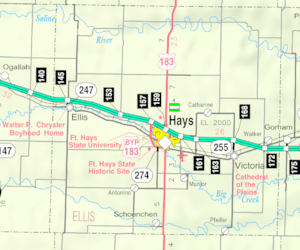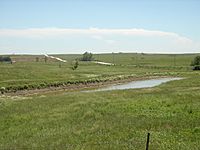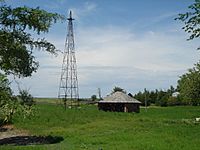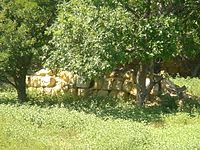Ellis County, Kansas facts for kids
Quick facts for kids
Ellis County
|
|
|---|---|

Ellis County Courthouse in Hays (1979)
|
|

Location within the U.S. state of Kansas
|
|
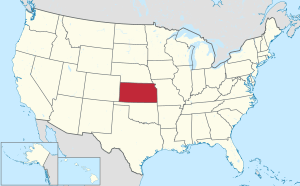 Kansas's location within the U.S. |
|
| Country | |
| State | |
| Founded | 1867 |
| Named for | George Ellis |
| Seat | Hays |
| Largest city | Hays |
| Area | |
| • Total | 900 sq mi (2,000 km2) |
| • Land | 899 sq mi (2,330 km2) |
| • Water | 0.5 sq mi (1 km2) 0.05%% |
| Population
(2020)
|
|
| • Total | 28,934 |
| • Density | 32.2/sq mi (12.4/km2) |
| Time zone | UTC−6 (Central) |
| • Summer (DST) | UTC−5 (CDT) |
| Area code | 785 |
| Congressional district | 1st |
Ellis County is a special area in the state of Kansas, USA. It's like a big neighborhood with its own local government. The main city and where the county government is located is Hays. In 2020, about 28,934 people lived here.
The county got its name from George Ellis. He was a first lieutenant in the Twelfth Kansas Infantry, a military group. Ellis County is also known as the "German Capital of Kansas." This is because many German immigrants came here in the 1870s and 1880s. They settled in places like Hays, Ellis, and Victoria.
Contents
History of Ellis County
How Ellis County Began
In 1854, the Kansas Territory was created. Then, in 1861, Kansas became the 34th state in the United States.
Ellis County was officially formed on February 16, 1873. The state government decided where its borders would be. But people had started moving here even earlier, in May 1867. A military fort called Fort Fletcher (later Fort Hays) was built in 1865.
The county set up its own government in October 1867. This happened after people asked Governor Samuel J. Crawford to make it official. Hays was chosen as the permanent county seat in April 1870.
Before Hays became the main city, some early settlers tried to start a town called Rome. It was just north of the railroad tracks. They hoped it would be the county seat. Rome had a store and a hotel. However, another company started a town called Hays City nearby. The railroad company supported Hays City, which was a big deal. So, Rome slowly disappeared. Many of its buildings, like the hotel, were moved to Hays City.
English and Russian-German Immigrants
At first, not many people moved to Ellis County. But in 1872, three new communities were started. George Grant, a rich Scottish businessman, bought a lot of land. He wanted to create a community for British farmers. About 300 farmers from England moved there.
Grant bought the land cheaply and sold it for more. He told immigrants it was cheaper than land in Britain. His first town was Victoria, named after Queen Victoria. He even brought special cattle from Britain.
However, many of the first British families were not farmers. They preferred hunting and living off money from their families. After Grant died in 1878, most of these British settlers went back home. A big problem with grasshoppers in 1874 also made many people leave.
Then, in 1875, many Russian immigrants arrived. These people were actually Volga Germans. Their families had moved to Russia in the 1760s. But in the 1870s, Russia changed its rules. They started making these Germans join the military. This made many of them want to leave Russia.
Some German delegates first explored Nebraska. Later, in December 1874, a group went to Topeka and Larned in Kansas. They didn't like what they saw at first. But because of the military rule, many Germans decided to move anyway.
They arrived in Baltimore in November 1875. Then they came to Topeka. Land there was too expensive. So, they were shown land in Ellis County. This land was cheaper.
On February 21, 1876, fourteen German families came to Hays. From there, they moved to Liebenthal in Rush County. Soon after, three families from Russia built homes in Catherine. On April 8, 1876, twenty-three families settled in the old British colony at Victoria.
More immigrants arrived in the summer of 1876. Some settled in Catherine, others in Topeka. Thirteen families came to Hays on August 20, 1876. They settled in Pfeifer the next day.
One of the biggest groups was 104 families in 1876. They settled in Herzog. The settlers of Munjor stayed in Herzog for two months. Then they moved to their own spot near Munjor.
More small groups of immigrants arrived in late 1876 and 1877. They settled in places like Pfeifer and Catherine. The German immigrants also founded Schoenchen in 1877. Some came directly from Schoenchen in Russia. Others moved from Liebenthal in Rush County.
By 1903, many immigrants had settled in Catherine. Munjor grew from 130 families in 1897 to 156 families by 1900. Herzog became the largest German settlement.
20th Century History
In 1942, the Walker Army Airfield was built. It was located northwest of Walker. Thousands of soldiers trained there during World War II. They learned to fly the Boeing B-29 Superfortress plane. After the war, the airfield was closed down. Most of its buildings were removed.
Geography
Ellis County covers about 900 square miles. Most of this is land, with only a tiny bit of water.
Rivers and Land
The Saline River flows across the northern part of the county. Eagle Creek is its main branch. Other rivers include Big Creek. Victoria Creek flows into Big Creek, and Big Creek flows into the Smoky Hill River. The Smoky Hill River crosses the southern part of the county. In the past, there were also some salt marshes.
The river banks had a lot of limestone rock. Around Hays City in the 1800s, there was also a lot of clay.
Neighboring Counties
- Rooks County (north)
- Osborne County (northeast)
- Russell County (east)
- Rush County (south)
- Ness County (southwest)
- Trego County (west)
Main Roads
 Interstate 70
Interstate 70 US-183
US-183
Airport
Hays Regional Airport is in Ellis County. It's mostly used for small planes. But it also has one commercial airline, United Express. This airline offers daily flights to Denver, Colorado.
People of Ellis County (Demographics)
The Hays Micropolitan Statistical Area includes all of Ellis County. This means Hays is a central city for the surrounding area.
The population of Ellis County has grown over time:
- 1870: 1,336 people
- 1900: 8,626 people
- 1920: 14,138 people
- 1950: 19,043 people
- 1980: 26,098 people
- 2020: 28,934 people
In 2000, there were 27,507 people living in the county. Most people were White (96.10%). About 2.37% of the population was Hispanic or Latino.
The average household had 2.35 people. About 28.80% of households had children under 18. The median age in the county was 33 years old. This means half the people were younger than 33, and half were older.
Education
Ellis County has several schools and colleges.
Public School Districts
- Ellis USD 388 (covers the western part of the county)
- Victoria USD 432 (covers the eastern part of the county)
- Hays USD 489 (covers the central part, including Hays city)
Private Schools
Universities and Colleges
- Fort Hays State University
- North Central Kansas Technical College
Communities
Many towns in Ellis County are named after the original German settlements in Russia. For example, Catherine is from Katherinenstadt, and Schoenchen is from Schoenchen in Russia.
Here are some of the communities in Ellis County:
Cities
- Ellis
- Hays (This is the county seat)
- Schoenchen
- Victoria
Unincorporated Communities
These are smaller communities that are not officially cities.
Ghost Towns
These are communities that used to exist but are no longer populated today.
- Chetolah
- Easdale
- Hog Back
- Mendota
- Norfolk
- Rome
- Smoky Hill
- Stockrange
- Turkville
Townships
Ellis County is divided into nine areas called townships. The cities of Ellis and Hays are separate from these townships for government purposes.
- Big Creek
- Buckeye
- Catherine
- Ellis
- Freedom
- Herzog
- Lookout
- Victoria
- Wheatland
Gallery
See also
 In Spanish: Condado de Ellis (Kansas) para niños
In Spanish: Condado de Ellis (Kansas) para niños



